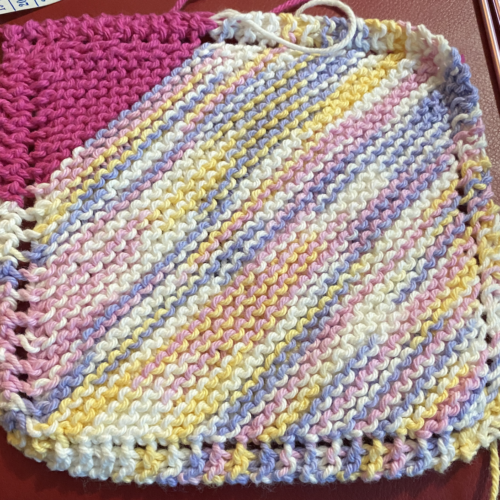Why write this pattern up?
Why have it tech edited?
Why spend time blogging about it?
Why, Why, Why?
Because…
— it’s where many of us started,
— it’s something we continue to use (even when we don’t recognize it),
— it deserves a little more attention,
— there is more value to be had from it than we may realize.
And most importantly, because it helps us learn something new.
New to knitting? This piece will help with small cast-ons, bind-offs, using increases and decreases and lots of knit and purl stitch practice.
New to a knitting style? Learning Continental or English style knitting? This is a great little piece to work on those skills. Knowing how to hold your yarn in both hands at the same time can make color work of any type much, much easier.
New to knitting on the bias? This is a small piece that shows the form and the construction. From here, they only get bigger. Understanding how bias knit fabric behaves — it stretches out corner to corner as it gets bigger — can help in using the technique in larger pieces.
New to knitting with cotton, bamboo or acrylics? Again, this little piece lets you create something useful while testing out a fiber you may not be familiar with. Then you get to see it in action, working its way through bath time, doing dishes and other chores or activities. How does it hold up for use? Over the long haul? In this case, it is a real swatch that has a purpose beyond finding mere gauge.
I knit several of these every year and we use them as dishcloths in our kitchen. Some have not come out quite right…too big, too floppy and loose, etc. and these have been repurposed in different places. As doilies or coasters they get to live in the house, I have a couple with my gardening stuff to wipe things down as needed.
I learned to knit Continental style, so when I wanted to do more color work I needed to practice holding the working yarn in my right hand. Up steps the little washcloth! I made my batch that year…slower than normal…while knitting strictly English style. When late summer came and I started planning my winter sweater knits, I found choosing color work pieces much easier than in the past. I wasn’t afraid of a 50″ sweater with multiple colors. I even started wandering into carrying 3 colors in a single row…tho very slowly.
The pattern itself it broken out into 4 sections:
- Casting On
- Increasin
- Decreasing
- Binding Off
For the new knitter, starting with the Knit Version and the 4 Stitch Cast On, continuing through the body sections and finishing with the 4 Stitch Bind Off would be the recommended path. For the second one, the Purl Version and either Cast On/Bind Off option. And no, you do not have to use the matching cast on and bind off on every one, it depends on your tolerance for asymmetry. If you need things to match, then match them. Otherwise, test away!
For those wanting to learn to knit Continental style, the Purl Version will be the challenge. Since I will assume basic cast ons, bind off, increases and decreases are already in your toolkit, simply pick your path through the pattern. Give yourself a little grace. Your hands already know how to knit (says your brain) and this is wrong! It will feel uncomfortable and you may battle with both a conscious or unconscious effort to knit the way you normally do. This is a good time to do some self-care and love yourself a little as you go back to feeling like an absolute beginner. You can also practice your patience, you ability to stay in the moment and how to knit without multi-taking. Take a deep breath and dive in.
If you are one for who this project is a stepping stone to a larger project, good for you! As you work through the increase and decrease sections, focus on how the shape of the piece — a square — is formed. Consider the adjustments that would be required to form a different shape: a rectangle? a parallelogram? a triangle? At the mid-point, consider how this triangle is shaped in comparison to a basic triangle shawl? Why?
My hope is to detail out some of these possibilities in the future: kitchen towel and dish rack drying towel, baby blanket, throw, shawl, modular blanket and so on. For now, I’m working on a pictorial for the newbie, both the knit and purl versions with both the 3- and 4-stitch cast ons and bind offs.
What do you think of a Knit-A-Long for this one? One that emphasizes the options it presents? I keep thinking about having knitters ‘pick their purpose’ for joining and then seeing what happens. The Basic Purpose group can do all the different versions of the basic pattern. Style groups can share their versions knit (or crocheted?) in the style that is not their ‘normal’. The Project group can show what they can do with it: stripes, patterns, shapes, colors, purpose.
Anybody want to join me? What’s your reason for working one of Grandma’s Favorite Washcloths? Got any other ideas for how to use it, customize it, make it your own? Share!

